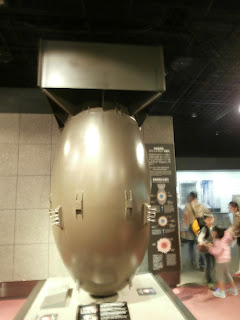Everything must say in English and Japanese!
The cruise Angie and I took recently went to ports in southern Japan (Yokohama, Kochi, Kagoshima, Nagasaki and Hiroshima) and South Korea (Jeju and Busan). All announcements were in English and Japanese, and there were always two emcees (the cruise director and his Japanese-speaking sidekick) for the nightly post-dinner shows. Even his "English" guffaws were dutifully echoed by her "Japanese" giggles.
But what I found hilarious -- but only now that the cruise is over -- was the mandatory Muster drill (ie, what to do in case we have to evacuate the ship, like, if it's sinking). Yes, that drill was in English and Japanese. There was this spiel in English that went on and on about staying calm and to follow directions and not to jump overboard but to always take instructions from the crew. All that was repeated in Japanese. It was a very long Muster drill session. Imagine this scenario in an actual evacuation of the ship...
In English: Please stay calm. We are starting to list on the port side and we must abandon ship. So please make your way to the starboard side and await the crew's instructions on boarding the available tender boats, blah blah blah...
By the time the Japanese spiel is made, it will probably sound like this:
Konnichiwa. Summimasen. Dozo... (gurgle), (gurgle), (gurgle)... [the ship is already under water].
-----------------------------------------------
A-Bomb, made in the USA, with Japanese component?
This picture above shows a replica of "Fat Man", the A-Bomb that was detonated over Nagasaki on Aug 9, 1945. It is displayed at the Nagasaki Atomic Bomb Museum, one of the places our land tour took us to.
The guide was very fluent in English, and she seemed very knowledgeable about that tragic event too. When I was looking at the cut-away showing the fissile (plutonium 239) core (pic below)...
... she came over and told me this: The fuze assembly that determined when the bomb would explode (it was set to do so as an "air-burst" explosion, not as a ground-impact explosion) was actually a Japanese-made device, as it was deemed the most reliable!
How do you say this Japanese term?
I picked up this brochure for a manga museum in one of the places we visited...
Better say it properly, man, or you'll get punched in the face!



No comments:
Post a Comment